The blue bird is a beloved sight in Oklahoma. From the bright blue male Eastern Bluebird to the slate blue female, these birds can be found throughout the state. They inhabit woodlands, grasslands, fields, and pastures, and they can be found in both rural and urban areas.
Not only are blue birds a beautiful sight, but they are also beneficial for the environment, as they eat a variety of insects, including the destructive beetle grubs that attack oak trees.
They are also a favorite of many bird watchers, as they are easily identified and often seen perched on wires or fence posts. In short, blue birds are an important part of Oklahoma’s ecosystem, and their presence is a welcome sight.
1. Eastern Bluebird

The Eastern Bluebird is a beautiful and captivating species of bird that is native to North America. It is a small thrush, generally measuring between 7 and 8 inches in length, and is migratory, meaning that it will migrate to different habitats depending on the season.
It can usually be found in woodlands, farmlands, and orchards, as these open areas provide it with plenty of food and places to nest.
During the breeding season, the male Eastern Bluebird takes on a beautiful bright blue plumage, which makes it stand out from the rest of its kind.
This is easily visible when perched on a wire or other open perch, and is a favorite of birders who often gather to admire its striking beauty.
The Eastern Bluebird has been long admired for its beauty, as well as its melodic song, which is often associated with the coming of spring.
| Kingdom | Animalia |
| Phylum | Chordata |
| Class | Aves |
| Order | Passeriformes |
| Family | Turdidae |
| Genus | Sialia |
| Species | S. Sialis |
2. Blue Jay
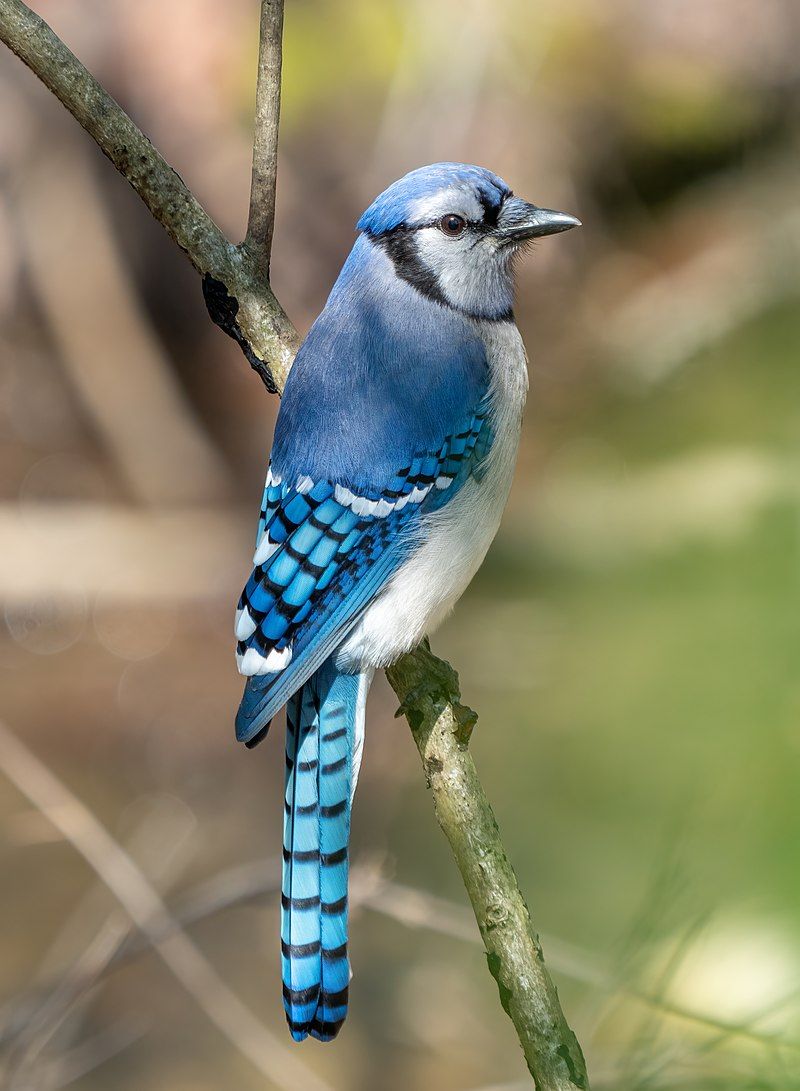
The blue jay is a type of passerine bird, meaning it is a perching bird, from the family Corvidae. It is native to eastern North America and lives in most of the eastern and central United States.
Some populations of these birds may migrate seasonally, while others may stay in the same area year-round. There are also resident populations of blue jays in Newfoundland, Canada. Additionally, there are breeding populations of blue jays spread across southern Canada.
This indicates that blue jays have a wide range across North America, and are able to adapt to a variety of habitats.
| Kingdom | Animalia |
| Phylum | Chordata |
| Class | Aves |
| Order | Passeriformes |
| Family | Corvidae |
| Genus | Cyanocitta |
| Species | C. cristata |
3. Indigo Bunting

The indigo bunting is a small, seed-eating bird in the cardinal family, Cardinalidae.
It is known to migrate over a large area, covering a range from southern Canada down to northern Florida during the breeding season, and then heading south from southern Florida all the way to northern South America during the winter.
To do so, the bird relies on the stars to guide it in its travels and usually migrates at night when the sky is clear. This allows the indigo bunting to travel long distances without losing its way and ensures that it can return to its breeding grounds each year.
The bird’s ability to navigate over long distances using the stars is a remarkable feat of adaptation and survival.
| Kingdom | Animalia |
| Phylum | Chordata |
| Class | Aves |
| Order | Passeriformes |
| Family | Cardinalidae |
| Genus | Passerina |
| Species | P. cyanea |
4. Barn Swallow
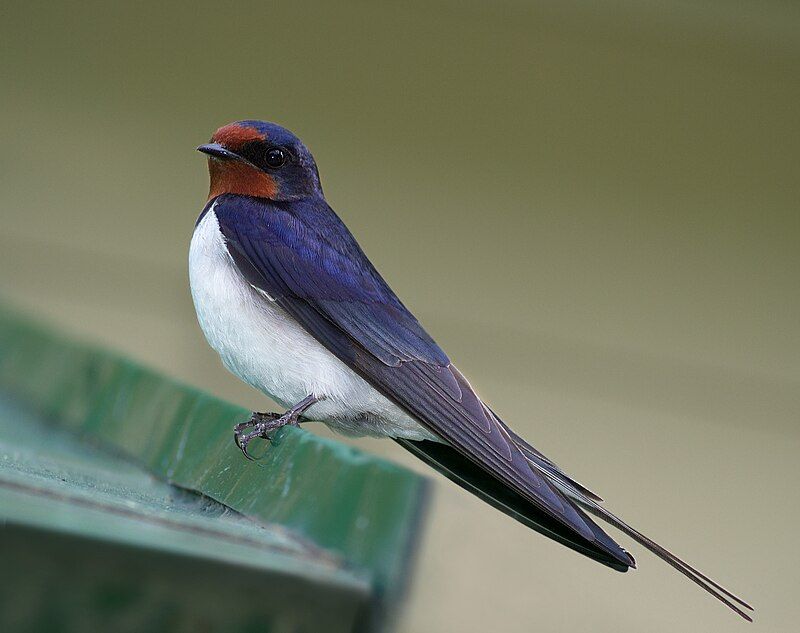
The barn swallow is a remarkable bird. It is one of the most common bird species in the world and has a wide-ranging natural habitat. It can be seen in a variety of habitats across 251 million square kilometers, from forests to wetlands, deserts to mountains.
Its distinctive appearance makes it easy to spot, with its blue upperparts and its very long, deeply forked tail. Its wings are also adapted for quick and efficient flight, allowing it to cover long distances over its vast range.
The barn swallow is an incredibly adaptable species, able to survive in many different habitats and even able to adjust its behavior to the different patterns of the seasons.
This has allowed it to become one of the most widespread passerines in the world, and its presence is a sign of the health of the local environment.
| Kingdom | Animalia |
| Phylum | Chordata |
| Class | Aves |
| Order | Passeriformes |
| Family | Hirundinidae |
| Genus | Hirundo |
| Species | H. rustica |
5. White-Breasted Nuthatch
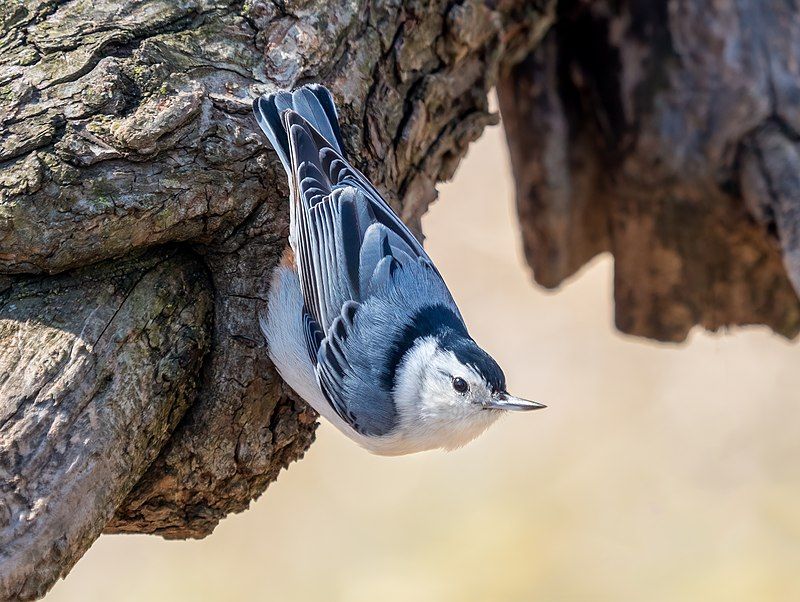
The white-breasted nuthatch is a species of bird that belongs to the Sittidae family, which is the family of nuthatches. It is a medium-sized bird, measuring approximately 15.5 cm in length. This bird is quite distinctive, with its white breast and grey upperparts.
Its head is also a shade of grey, with a black crown and black striping. The beak is slightly curved, and the legs and feet are grey. Its wings are short and rounded, and its tail is long and slightly notched.
The white-breasted nuthatch is a cavity-nesting bird, building its nest in natural cavities or tree hollows. It forages mainly on tree trunks and branches, searching for insects and other invertebrates.
This species is also known to eat seeds and nuts and is an important disperser of pine seeds in some areas of its range. The white-breasted nuthatch is found across much of North and Central America, from Alaska to Mexico.
It is a common bird in many areas and is usually seen in small flocks.
| Kingdom | Animalia |
| Phylum | Chordata |
| Class | Aves |
| Order | Passeriformes |
| Family | Sittidae |
| Genus | Sitta |
| Species | S. carolinensis |
6. Common Grackle

The common grackle is a species of large icterid bird found predominantly throughout North America. First described in 1758 by renowned Swedish biologist Carl Linnaeus, the common grackle consists of three subspecies.
An adult common grackle typically boasts a long and dark bill, yellow-hued eyes, and a relatively long tail. They are often seen in large numbers in their natural environment, foraging for food and socializing with other members of the species.
Common grackles have a wide range of vocalizations that vary from location to location, and they are known to be particularly adept at adapting to urban living. The common grackle is a magnificent species that is known for its beauty and distinctive call.
| Kingdom | Animalia |
| Phylum | Chordata |
| Class | Aves |
| Order | Passeriformes |
| Family | Icteridae |
| Genus | Quiscalus |
| Species | Q. quiscula |
7. Red-Breasted Nuthatch

The red-breasted nuthatch is a small songbird native to North America.
It can be identified by its unique combination of blue-grey upper parts, cinnamon-colored underparts, a white throat and face with a black stripe going through the eyes, and a straight grey bill and black crown.
The bird’s call is high-pitched and nasal and has been likened to a tin trumpet. It is also known for its curious behavior of walking down tree trunks headfirst, which is unusual among songbirds.
The red-breasted nuthatch is an important part of North American forests, as it is an indicator species for forest health and plays a role in pest control. Its diet consists of insects, spiders, and seeds.
The bird is relatively common throughout its range and is not considered to be threatened at this time.
| Kingdom | Animalia |
| Phylum | Chordata |
| Class | Aves |
| Order | Passeriformes |
| Family | Sittidae |
| Genus | Sitta |
| Species | S. canadensis |
8. Blue-Gray Gnatcatcher

The blue-gray gnatcatcher is a species of small songbird native to North America. It is related to the Old World warbler family and is one of the smallest of the North American birds. The blue-gray gnatcatcher has an olive-gray back and head, a white belly, and a black tail.
It has a distinct call, which is a combination of chirps and trills. The birds typically forage in open woods, thickets, and edges of woodland, as well as along streams and in weedy fields. They are most active in the morning and evening when they are foraging for insects.
The blue-gray gnatcatcher is a migratory bird, breeding in the southeastern United States and wintering in the Gulf Coast region and Mexico. They are often found in small flocks during migration.
The blue-gray gnatcatcher is an important indicator species, telling us about the health of an ecosystem. They are vulnerable to habitat destruction and other human disturbances, so their presence is used to gauge the health of an area.
| Kingdom | Animalia |
| Phylum | Chordata |
| Class | Aves |
| Order | Passeriformes |
| Family | Polioptilidae |
| Genus | Polioptila |
| Species | P. caerulea |
9. Cerulean Warbler

The cerulean warbler is a species of songbird that belongs to the family Parulidae. It is a migratory bird, breeding in the hardwood forests of eastern North America and then flying south in the winter months to the eastern slopes of the Andes in South America.
The warbler prefers subtropical forests for its winter destination, suggesting that it has adapted to the warmer temperatures found in these regions.
The cerulean warbler’s migratory Behaviour is quite remarkable, as it is able to cover such long distances in a relatively short period of time. It is also an impressive feat of navigation, as the bird must have some sort of internal compass to guide it to its destination.
It is quite likely that environmental cues, such as the position of the sun and the stars, help the warbler orient itself during its long journey.
The cerulean warbler is an important species in eastern North American forests, as its presence is essential for maintaining healthy ecosystems.
Its diet consists of a variety of insects, which it eats to fuel its long migrations and to provide the energy needed to reproduce and raise its young.
Without the cerulean warbler, the insect populations in these areas would likely increase, resulting in a disruption of the delicate balance of these ecosystems.
In conclusion, the cerulean warbler is an impressive species of songbird that has adapted to living in two very different environments. Its migratory behavior is remarkable, and its presence in eastern North American forests is essential for maintaining healthy ecosystems.
| Kingdom | Animalia |
| Phylum | Chordata |
| Class | Aves |
| Order | Passeriformes |
| Family | Parulidae |
| Genus | Setophaga |
| Species | S. cerulea |
10. Blue Grosbeak
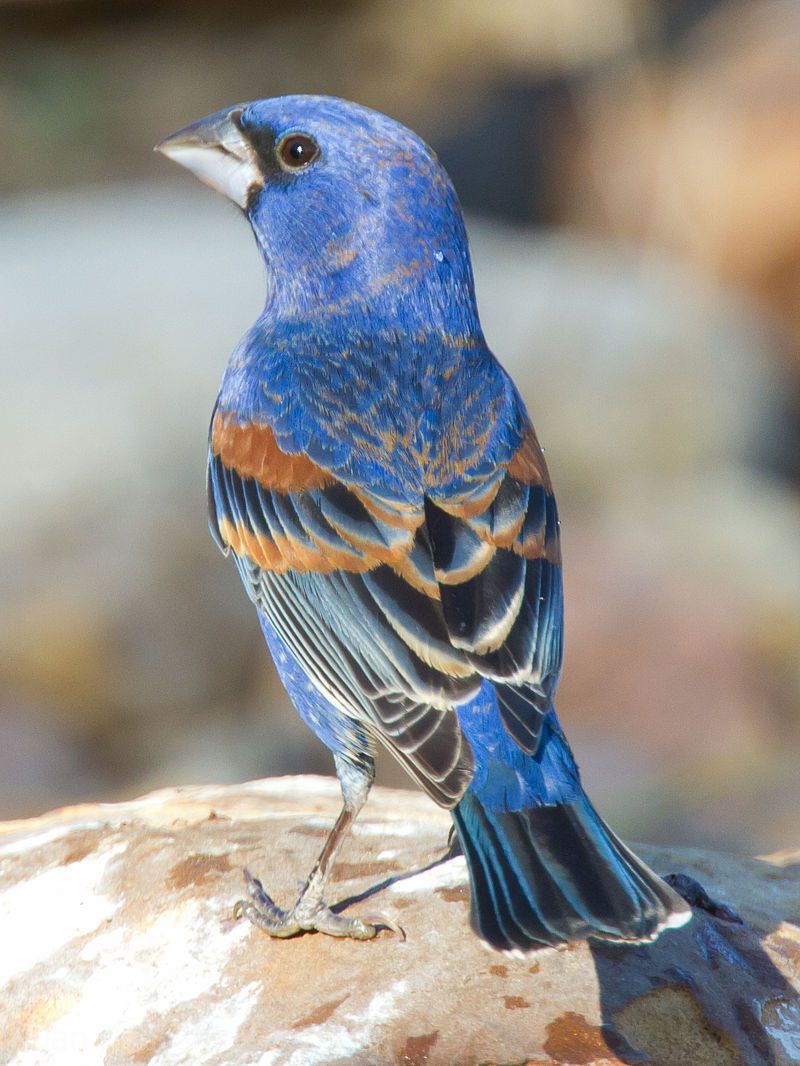
The blue grosbeak is a beautiful species of bird found in North America. It belongs to the cardinal family and is a medium-sized passerine bird. It has stunning blue plumage and two brown wing bars.
This species is mainly migratory and spends its winters in Central America while breeding in northern Mexico and the southern United States. The male blue grosbeak is especially striking, with its bright blue color and brown wing bars.
The female blue grosbeak is less colorful, having a dull grey-brown color. Both sexes have a large, conical bill which is black in color. The blue grosbeak is a social species, often seen in pairs or small flocks.
They feed on a wide variety of seeds, fruits, and insects, and can often be seen in open woodlands and fields.
The blue grosbeak is an important species in the bird world, as it plays an important role in the ecosystem by dispersing seeds and helping to control insect populations.
The blue grosbeak is an important species to monitor, as its population has been declining in recent years due to habitat loss and climate change. It is important to protect and conserve their habitat in order to ensure that this beautiful species continues to thrive.
| Kingdom | Animalia |
| Phylum | Chordata |
| Class | Aves |
| Order | Passeriformes |
| Family | Cardinalidae |
| Genus | Passerina |
| Species | P. caerulea |
11. Belted Kingfisher
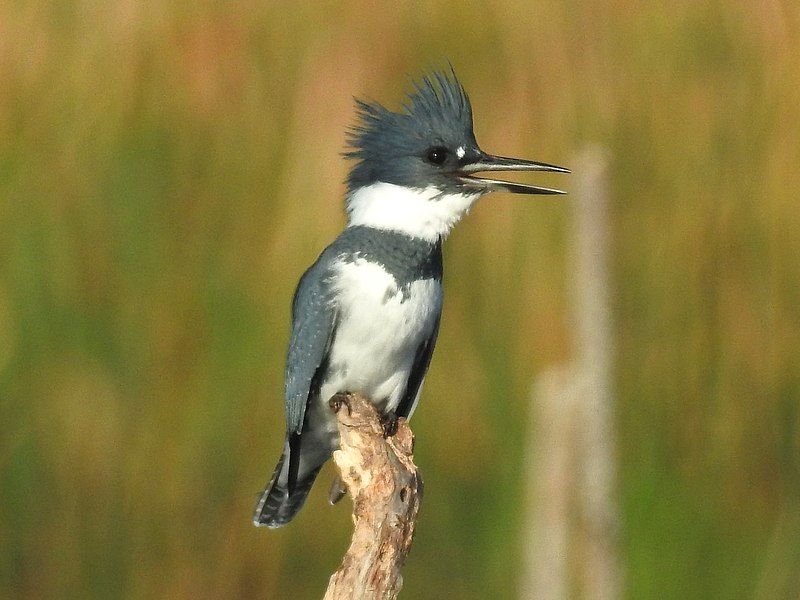
The belted kingfisher is a large, easily recognizable bird found in North America. It belongs to the family of water kingfishers of the order Coraciiformes, which also includes bee-eaters and rollers.
Until recently, all of the kingfishers were placed in the same family, Alcedinidae. However, due to new research, Alcedinidae is now divided into three distinct subfamilies.
These subfamilies are Cerylinae, which includes the river kingfishers; Halcyoninae, which includes the tree kingfishers; and Alcedininae, which includes the water kingfishers.
The belted kingfisher is part of the Alcedininae subfamily and is easily identifiable by its large size, distinctive markings, and vibrant colors. The belted kingfisher is also known for its loud, rattling call, which can be heard from a long distance.
Overall, the belted kingfisher is an impressive and iconic species found in North America.
| Kingdom | Animalia |
| Phylum | Chordata |
| Class | Aves |
| Order | Coraciiformes |
| Family | Alcedinidae |
| Genus | Megaceryle |
| Species | M. alcyon |
12. Purple Martin

The purple martin is a species of bird belonging to the Hirundinidae family of passerines, or songbirds. This species is the largest of all swallows in North America and as its name suggests, its plumage typically features shades of purple.
However, it is interesting to note that the purple martin is not actually entirely purple in color, but rather its feathers are a combination of blues, grays, and purples. The purple martin has a distinctively long, forked tail and a black head and face with white cheeks.
This species is found throughout much of North America, migrating south during the winter months. It mainly feeds on insects, such as flying ants and termites, which it captures in mid-air.
The purple martin prefers to build its nest in man-made structures such as birdhouses and gourds, and it is often kept as a pet by bird enthusiasts.
| Kingdom | Animalia |
| Phylum | Chordata |
| Class | Aves |
| Order | Passeriformes |
| Family | Hirundinidae |
| Genus | Progne |
| Species | P. subis |
13. American Robin
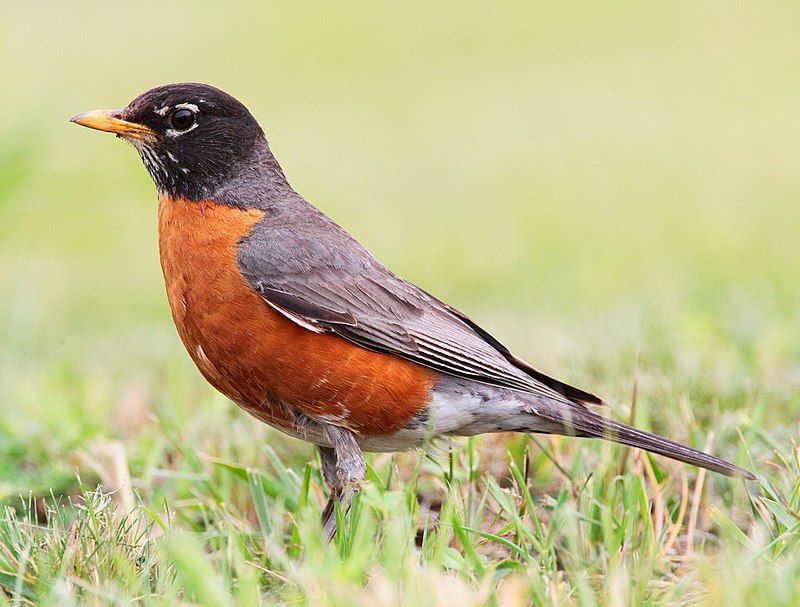
The American robin is a migratory bird that belongs to the true thrush genus and the Turdidae family, which is part of the wider thrush family. It gets its name from the European robin due to its reddish-orange breast, although the two species are not related.
The European robin belongs to the Old World flycatcher family. Migratory birds are those that travel from one place to another in regular seasonal patterns, usually for purposes of breeding or finding food.
The American robin is a migratory bird that lives in North America and can be spotted in gardens, parks, and woodlands. It is a medium-sized bird that is easily recognizable due to its reddish-orange breast.
The American robin is not closely related to the European robin, which belongs to the Old World flycatcher family. The two species are similar in appearance, but the Old World flycatcher family is a different group of birds.
The American robin is part of the true thrush genus and the Turdidae family, which is part of the wider thrush family. The American robin is also known for its distinctive song, which consists of several melodic notes.
In conclusion, the American robin is a migratory bird that is part of the true thrush genus and the Turdidae family. It gets its name from the European robin due to its reddish-orange breast, although the two species are not related.
The European robin belongs to the Old World flycatcher family. The American robin is recognizable due to its distinctive song and its reddish-orange breast.
| Kingdom | Animalia |
| Phylum | Chordata |
| Class | Aves |
| Order | Passeriformes |
| Family | Turdidae |
| Genus | Turdus |
| Species | T. migratorius |
14. Northern Parula

Source: dibird.com
The northern parula is a species of small songbird belonging to the Warbler family. It is native to North America and is commonly found in eastern parts of the continent, from as far north as Canada, down to Florida.
This bird is particularly interesting due to its bright and vivid plumage. The upper parts of the northern parula are a yellowish-green color, while its underparts are a bright yellow. Its head features a white forehead and a prominent blue patch on its cheeks.
It also has two white wing bars on its wings. The northern parula breeds during the summer months in the eastern part of North America and migrates south to its wintering grounds in the southern United States and Mexico during the colder months.
They can typically be found in open woodlands, near streams, and in marshy areas. These birds feed primarily on insects, which they glean from the bark of trees and shrubs. They also feed on spiders and other arthropods.
Northern parulas are known for their loud, melodic songs which they sing throughout the day.
| Kingdom | Animalia |
| Phylum | Chordata |
| Class | Aves |
| Order | Passeriformes |
| Family | Parulidae |
| Genus | Setophaga |
| Species | S. Americana |
15. American Goldfinch

Source: kids.nationalgeographic.com
The American goldfinch is a small songbird that is native to North America. It belongs to the finch family and is a migratory species.
During the breeding season, it ranges from mid-Alberta to North Carolina, while during the winter, it can be found near the Canada-US border, extending all the way down to Mexico. The goldfinch is a small bird, with a bright yellow plumage and a black cap on its head.
Its wings are black with a white bar, and its tail is black with white edges. It is a common sight in many gardens and parks across the continent, where it can often be seen perched on branches or flitting between flower heads, searching for nectar and seeds.
The American goldfinch is a welcome sight in the spring and summer months, when they can be seen in large flocks, flying between trees and shrubs.
| Kingdom | Animalia |
| Phylum | Chordata |
| Class | Aves |
| Order | Passeriformes |
| Family | Fringillidae |
| Genus | Spinus |
| Species | S. tristis |
16. New World Warblers

The New World warblers are a family of birds belonging to the family Parulidae, and they are unique to the Americas. They are quite small in size, ranging from 5-20 cm in length, and often brightly colored.
These birds are also referred to as wood warblers, due to their preference for woodland habitats. They are not closely related to Old World warblers, which are mostly found in Europe, Asia, and Africa, nor to Australian warblers, which are found solely in Australia.
Instead, the New World warblers are more closely related to other American birds, like thrushes, tanagers, and flycatchers. The New World warblers have a variety of distinctive characteristics, including a large, rounded head, a short, thin bill, and a long, pointed tail.
They also have an especially wide range of vocalizations, making them a favorite among birders. The most well-known species of New World warbler is the American Redstart, which is renowned for its beautiful red and black plumage.
| Kingdom | Animalia |
| Phylum | Chordata |
| Class | Aves |
| Order | Passeriformes |
| Family | Parulidae |
17. House Finch
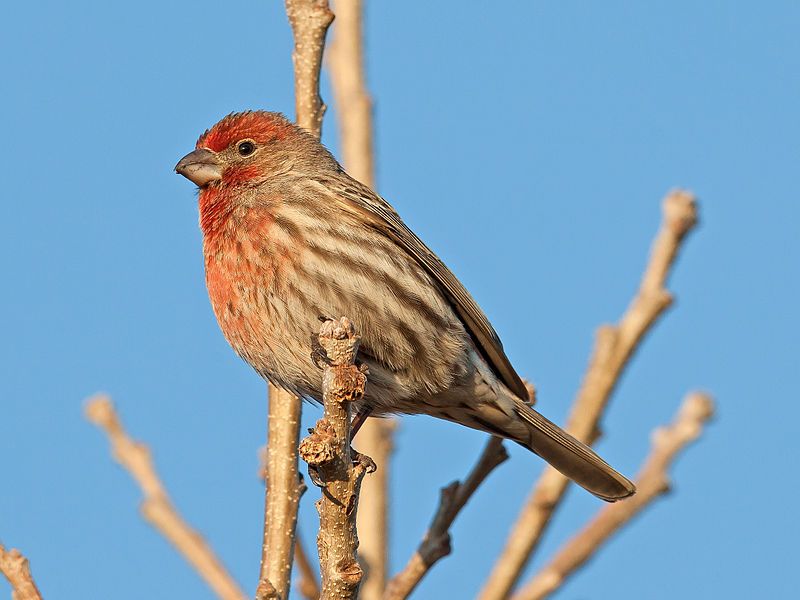
The house finch is a species of finch found in the Fringillidae family, which is native to western North America. It has since been introduced to the eastern half of the continent as well as Hawaii.
The house finch is one of three American rosefinches and is placed in the genus Haemorhous, along with its two other relatives. This genus is known for its several species of finches, and the house finch is the most abundant and widespread of them all.
The house finch is a small, brownish-grey bird with a bright red forehead, rump, and upper chest. It has a long, forked tail and a conical beak. This species is a seed eater and is often seen at bird feeders, making it a popular backyard bird.
Its song consists of a series of short, high-pitched whistles, making it a familiar and well-loved sound in many neighborhoods.
| Kingdom | Animalia |
| Phylum | Chordata |
| Class | Aves |
| Order | Passeriformes |
| Family | Fringillidae |
| Genus | Haemorhous |
| Species | H. mexicanus |
18. Common Starling

The common starling is a species of bird belonging to the Sturnidae family, also known as the starling family. It is a medium-sized passerine bird, which is found in many parts of the world such as North America, Great Britain, and Ireland.
It is often referred to as the European starling in North America and simply as the starling in Great Britain and Ireland. The common starling is a fairly large bird, with a wingspan of around 25-30 cm and a length of around 20-25 cm.
It has a glossy black plumage, with a metallic green and purple sheen. The underside of the wings is white, and the bird has a short, pointed beak. The tail is long and slender, with a white tip.
The common starling is an omnivorous bird, which feeds on a variety of insects, fruits, seeds, and grains. It is a very social bird and can often be seen in large flocks, which can even number in the thousands.
It is known for its intelligence and its ability to mimic human speech, as well as the songs of other birds. The common starling is a noisy bird, and its chattering can often be heard in urban areas.
It is a common sight in parks, fields, and gardens, where it feeds on insects, berries, and other food sources. The common starling is also a popular pet, due to its intelligence and its ability to mimic human speech.
| Kingdom | Animalia |
| Phylum | Chordata |
| Class | Aves |
| Order | Passeriformes |
| Family | Sturnidae |
| Genus | Sturnus |
| Species | S. vulgaris |
19. Red-Winged Blackbird
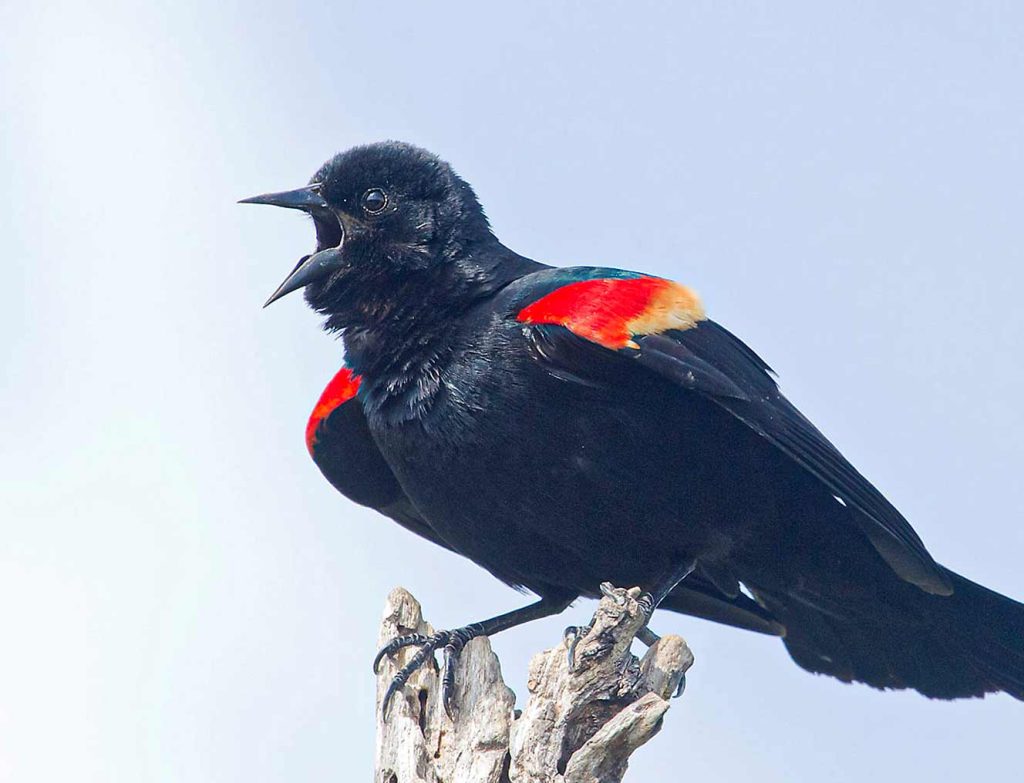
Source: vtecostudies.org
The red-winged blackbird is a type of songbird belonging to the family Icteridae. It is found in a wide area spanning from North America to Central America. The bird has a distinctive appearance, with a glossy black body, yellow shoulder patches, and its namesake red wings.
Its song is a common sound in its natural habitats, and it is often seen perched atop reeds, cattails, or other tall vegetation. The red-winged blackbird is an opportunistic feeder, eating a variety of insects, seeds, grains, and even small amphibians and reptiles.
It typically forages in fields, marshes, and other open habitats, often in large flocks. It is also a highly social bird, forming large colonies and frequently engaging in collective singing.
The red-winged blackbird is an important species in its ecosystem, providing important sources of food for many predators, as well as serving as a pollinator. It is also a popular bird for birdwatchers, as its striking colors make it an easy species to identify.
As a result, it is an important species for conservation, and it is listed as least concern on the IUCN Red List.
| Kingdom | Animalia |
| Phylum | Chordata |
| Class | Aves |
| Order | Passeriformes |
| Family | Icteridae |
| Genus | Agelaius |
| Species | A. phoeniceus |
20. Tufted Titmouse

The tufted titmouse is a small songbird native to North America, belonging to the tit and chickadee family. It is easily identified by its distinctive tufted head plumage.
The tufted titmouse is found throughout much of the eastern and central United States, as far north as Maine and as far south as northern Florida. The black-crested titmouse is a closely related species, found in the southern United States from central and southern Texas southward.
It was once considered a subspecies of the tufted titmouse but is now classified as a separate species, Baeolophus atricristatus.
The black-crested titmouse is distinguished by its black crest and grayish-white underparts, while the tufted titmouse has a grayish-brown crest and white underparts.
Both species have grayish-brown upperparts and yellowish-white eyebrows. The tufted titmouse and the black-crested titmouse both feed on insects, seeds, and berries. They are often seen in small flocks, scouring the trees and shrubs for food.
Both species of titmouse are cavity nesters, building their nests in tree cavities or old woodpecker holes.
They are also known to use nest boxes and other man-made nest cavities. In addition to their small size and distinctive plumage, the tufted titmouse and the black-crested titmouse are known for their melodious songs, which they use to communicate with each other.
These birds are beloved by birdwatchers and backyard birders alike, and can often be seen in gardens and parks.
| Kingdom | Animalia |
| Phylum | Chordata |
| Class | Aves |
| Order | Passeriformes |
| Family | Paridae |
| Genus | Baeolophus |
| Species | B. bicolor |
21. Brown-Headed Cowbird
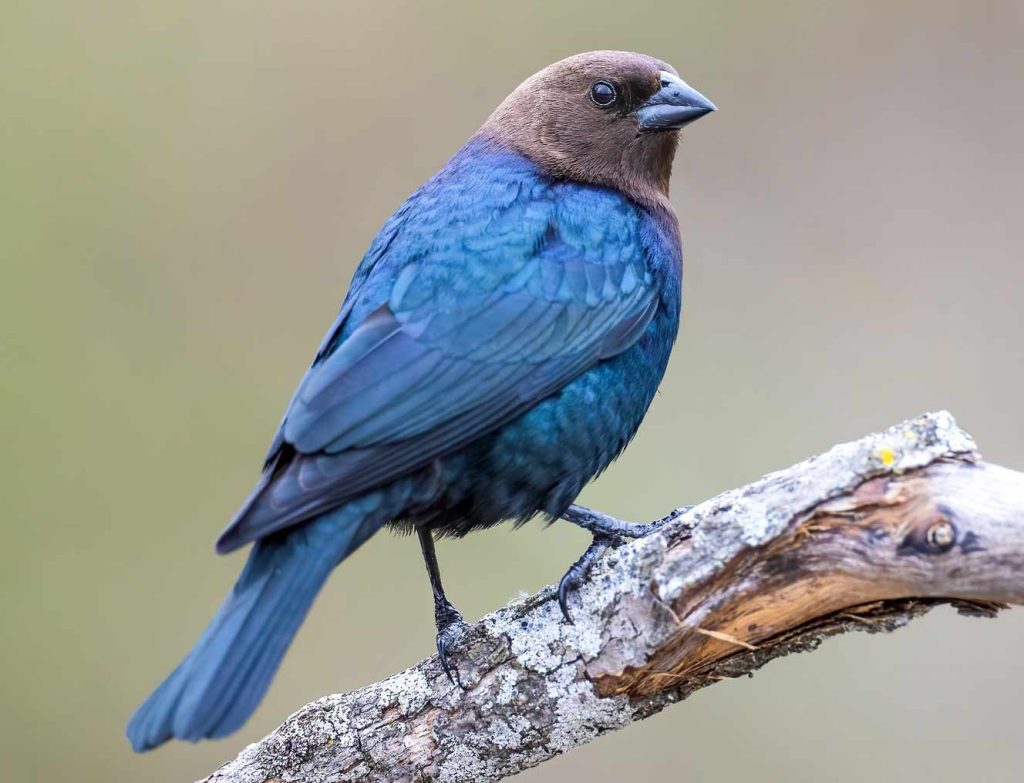
Source: ebird.org
The brown-headed cowbird is a small, blackbird-like bird that is native to North America. It is an obligate brood parasite, meaning that it lays its eggs in other birds’ nests.
It is an icterid, a type of blackbird, and is found in both temperate and subtropical areas of North America.In the southern parts of its range, the brown-headed cowbird is a permanent resident, while in the northern parts of its range, the birds migrate south to the United States and Mexico during the winter months.
These birds typically start their migrations in October or November and return to their summer habitats in March or April. The brown-headed cowbird is an important part of the North American avian ecosystem, as its migratory habits help to spread its genes throughout its range.
| Kingdom | Animalia |
| Phylum | Chordata |
| Class | Aves |
| Order | Passeriformes |
| Family | Icteridae |
| Genus | Molothrus |
| Species | M. ater |
22. Pyrrhuloxia

The pyrrhuloxia is a type of songbird that is native to the United States and Mexico. It is found in the desert regions of these two countries, primarily in the American Southwest and northern Mexico. It is a medium-sized bird, with a short, stout bill and red crest and wings.
This species is similar to the northern cardinal and the vermilion cardinal, which are both in the same genus. Pyrrhuloxia is easy to identify due to its distinct features.
Its red crest and wings stand out against the otherwise dull desert landscape and its short, stout bill gives it a unique appearance.
The bird’s coloring is a combination of gray, brown, and red, with a white underbelly and black streaks on its back. The pyrrhuloxia’s diet consists primarily of insects, seeds, and fruits. It will also eat small lizards and snakes.
It is an active forager, often traveling in flocks as it searches for food. It is also an avid vocalist, singing in the mornings and evenings. Pyrrhuloxia is a species that is both unique and adaptable.
Its striking appearance and cheerful singing make it a beloved sight in the desert regions of the United States and Mexico. It is a reminder of the beauty that can be found in even the driest of places.
| Kingdom | Animalia |
| Phylum | Chordata |
| Class | Aves |
| Order | Passeriformes |
| Family | Cardinalidae |
| Genus | Cardinalis |
| Species | C. sinuatus |
23. Gray Catbird
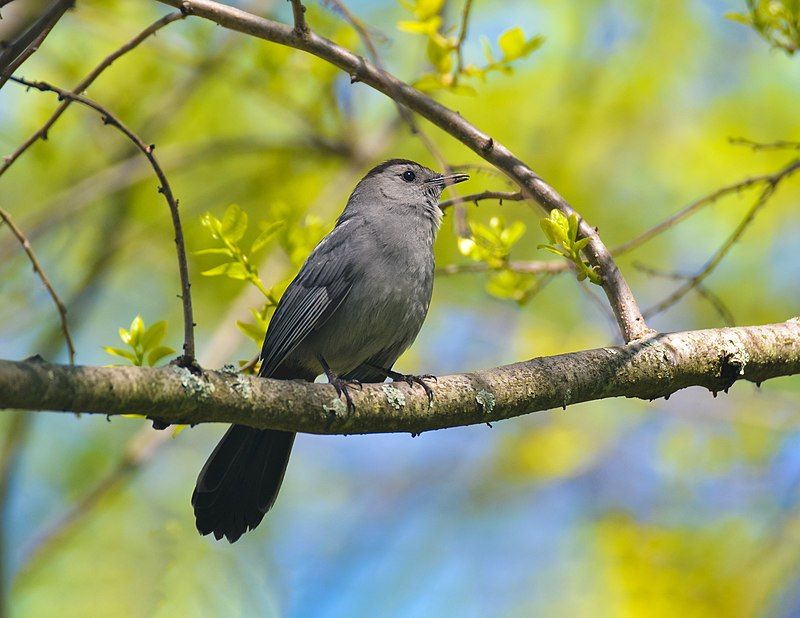
The gray catbird, also known as the grey catbird, is a species of perching bird found in North America and Central America. It belongs to the Mimidae family, which includes other species such as mockingbirds, thrashers, and crows. It is the only member of its genus, Dumetella.
The gray catbird is a medium-sized bird, about 10-12 inches long, with a gray head, an ashy-gray back, and a rusty-colored tail. Its wings have dark bars, and its throat and chest are white.
It has a distinctive call, which is a loud, cat-like meowing. The gray catbird is most commonly seen in wooded areas near open areas, such as fields or roadsides. It feeds on insects and fruits and prefers to feed in shrubs and low trees.
It is quite tame and will often approach people, particularly if it is being fed. It breeds in the northern part of its range during the summer months, and in the southern part of its range during the winter.
The nest is a cup-shaped structure made from twigs and grasses and is usually placed in a shrub or low tree. The female lays two to five eggs, which are pale blue with dark spots.
The young fledge after about two weeks. The gray catbird is an important part of its ecosystem, helping to control insect populations and dispersing seeds. It is a very vocal species, with a variety of calls, including the distinctive meowing call.
It is an enjoyable bird to watch and can make an interesting addition to any backyard.
| Kingdom | Animalia |
| Phylum | Chordata |
| Class | Aves |
| Order | Passeriformes |
| Family | Mimidae |
| Genus | Dumetella |
| Species | D. carolinensis |
24. Blue-Headed Vireo
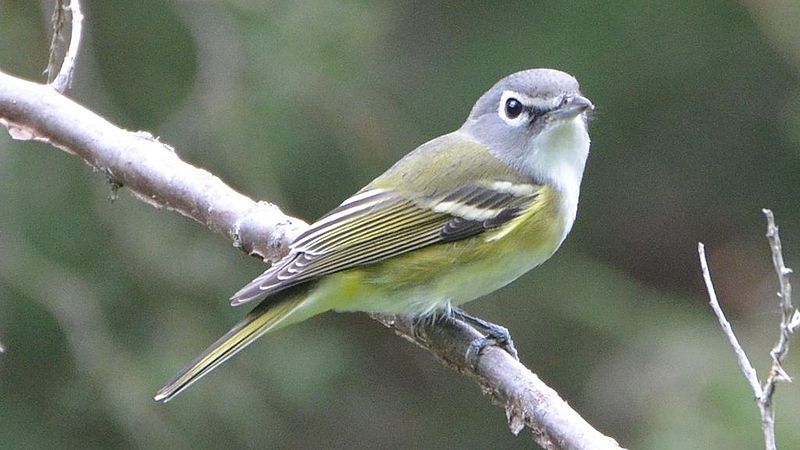
The blue-headed vireo is a migratory songbird that can be found throughout North and Central America. It has two distinct subspecies that are both recognized by scientists.
The bird’s range extends from Canada to the eastern coast of the United States, and further south to Mexico and some parts of Central America.
The blue-headed vireo is a very versatile bird, able to survive in a variety of habitats, including woodlands, grasslands, and even urban areas. Its diet consists mainly of insects, berries, and seeds.
The bird’s population has been declining in recent years due to habitat loss, climate change, and other factors. Conservation efforts are being made to ensure the blue-headed vireo’s survival, including habitat protection, population monitoring, and public education.
| Kingdom | Animalia |
| Phylum | Chordata |
| Class | Aves |
| Order | Passeriformes |
| Family | Vireonidae |
| Genus | Vireo |
| Species | V. solitarius |
25. Red-Winged Blackbirds
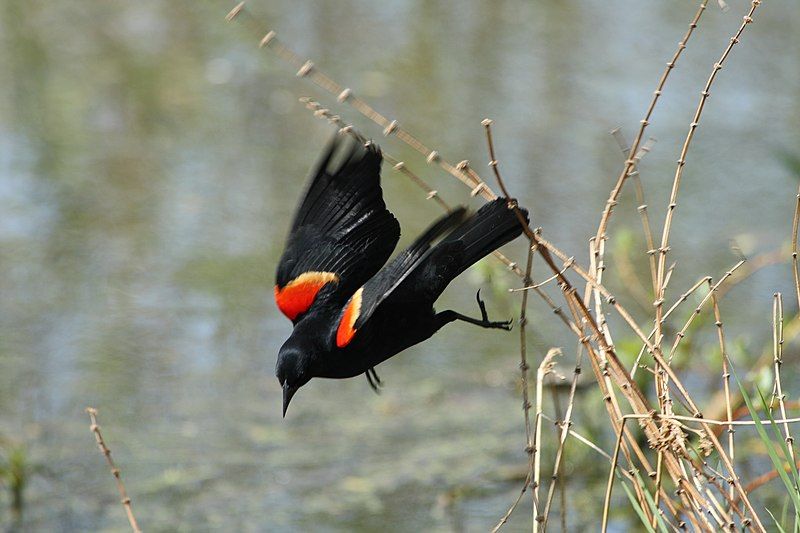
Agelaius is a genus of blackbirds that belongs to the New World family Icteridae. It was first introduced by French ornithologist Louis Jean Pierre Vieillot in 1816 and currently contains five species within the genus.
The name is Agelaius derives from the Greek word “agelaios”, which means gregarious, likely in reference to the social nature of blackbirds. All species within this genus are known to be highly social and mostly live together in large flocks.
They are usually found in open woodlands, grasslands, and wetlands, and are omnivorous, meaning their diet consists of both plants and animals. They have a wide range of calls and a wide variety of songs that are used to communicate with each other and to attract mates.
Agelaius blackbirds are important species in many ecosystems, feeding on insects that can be agricultural pests and helping to disperse the seeds of many plants.
| Kingdom | Animalia |
| Phylum | Chordata |
| Class | Aves |
| Order | Passeriformes |
| Family | Icteridae |
| Genus | Agelaius |
26. Gnatcatcher
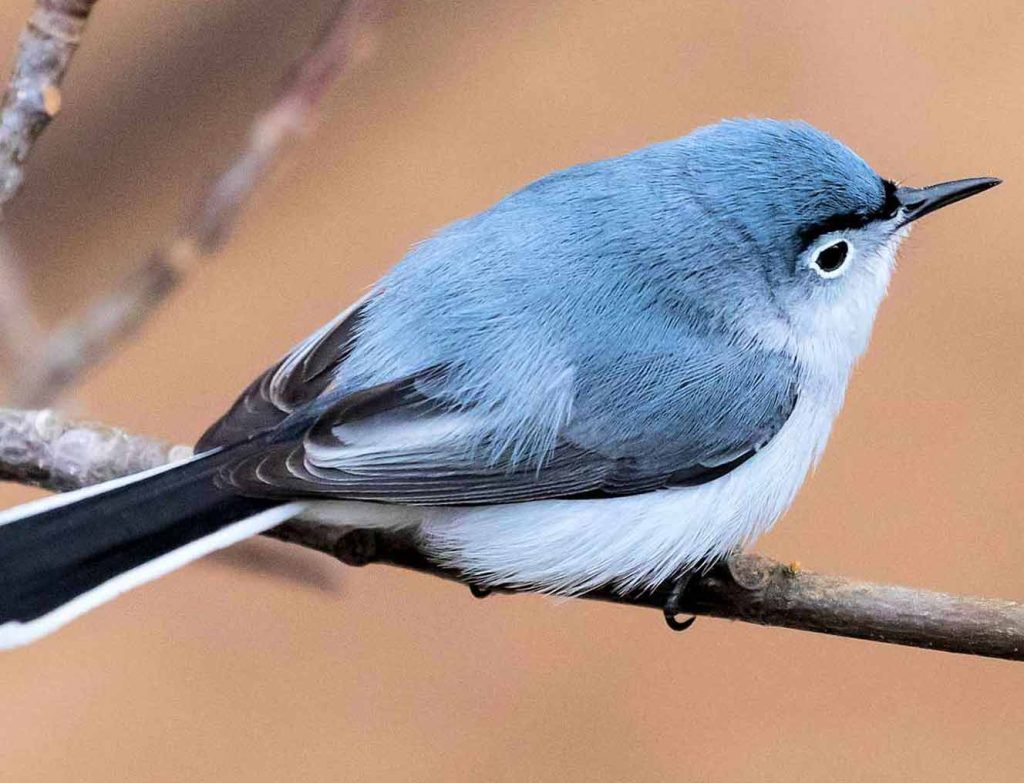
Source: thespruce.com
Gnatcatchers are a family of small passerine birds found in the Americas, specifically in North and South America. This family is known as the Polioptilidae family and consists of 21 species.
The majority of these species are mainly tropical and subtropical birds which are resident, meaning they remain in the same place all year round. However, the blue-grey gnatcatcher, which is found in the United States and southern Canada, is a migratory species.
This means that during the winter, the blue-grey gnatcatcher will migrate south to warmer climates. This type of behavior is typical of many migratory birds, as it allows them to survive the cold winter months and find more abundant food sources.
| Kingdom | Animalia |
| Phylum | Chordata |
| Class | Aves |
| Order | Passeriformes |
| Family | Polioptilidae |
27. Lazuli Bunting

The lazuli bunting is a beautiful songbird found in North America. Its name comes from the gemstone lapis lazuli, which is known for its deep blue color. This bird has a bright blue back, a rusty chest, and a white belly.
Its head is a vibrant blue, and it has a black stripe running through its eyes. The wings and tail are also blue, and the beak and legs are black. These birds are found in open woodlands, meadows, and fields, where they forage for insects and seeds.
They often nest in shrubs and trees. The male lazuli bunting is particularly famous for its beautiful, melodic song. It is a favorite of birdwatchers and nature lovers alike.
| Kingdom | Animalia |
| Phylum | Chordata |
| Class | Aves |
| Order | Passeriformes |
| Family | Cardinalidae |
| Genus | Passerina |
| Species | P. amoena |
28. Great Blue Heron

The great blue heron is a majestic creature that can be found in many parts of the world. It is a large wading bird that belongs to the heron family, Ardeidae. It is most commonly found near the shores of open water, such as lakes and rivers, as well as in wetlands.
From North and Central America to South America and the Caribbean, the great blue heron is a widespread species that can also be found in the Galápagos Islands. The great blue heron is a distinctive bird, with a large, long neck and a long, pointed beak.
It has a slate blue body and wings with white feathers on its head, neck, and chest. Its long legs are a yellowish color, and its feet are webbed, allowing it to swim in the water.
The great blue heron is an opportunistic predator, feeding on small fish, amphibians, reptiles, insects, and crustaceans. In addition to its impressive physical features, the great blue heron is also noted for its impressive courtship and mating behavior.
The bird will perform a courtship ritual that includes strutting, bowing, and dancing around its mate.
Once paired, the birds will build a nest together, typically in a tree or on a platform, and will share the responsibility of incubating the eggs and raising the young. The great blue heron is an important species to many of the wetlands and ecosystems it inhabits.
It is an important link in the food chain and helps to keep aquatic and insect populations in check. As a result, it is an important species to conserve.
| Kingdom | Animalia |
| Phylum | Chordata |
| Class | Aves |
| Order | Pelecaniformes |
| Family | Ardeidae |
| Genus | Ardea |
| Species | A. herodias |
29. Snowy Egret
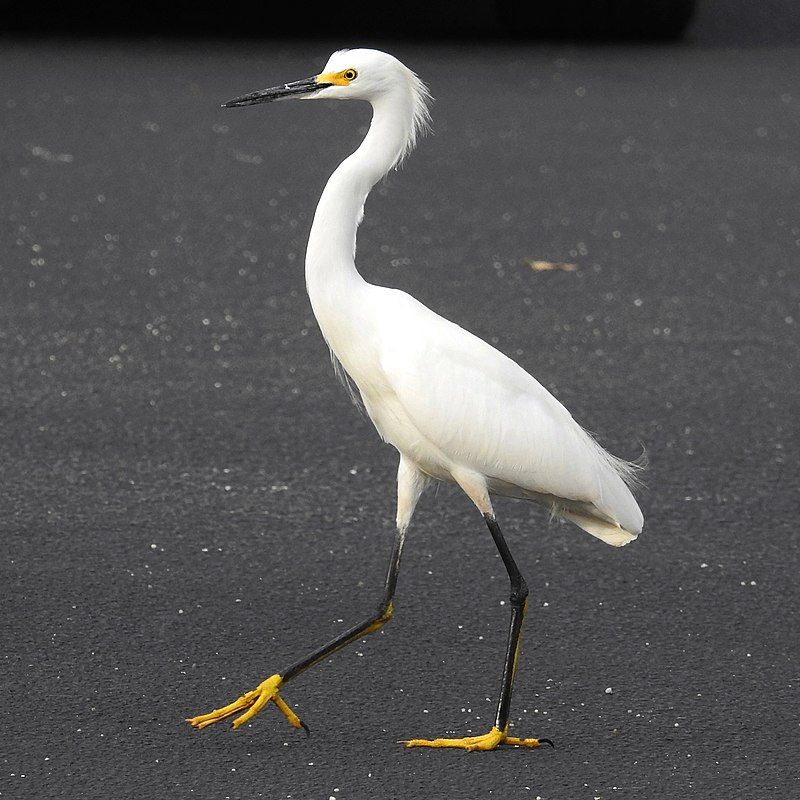
The snowy egret is a small white heron that is native to many parts of the world. The genus name of the snowy egret, Egretta thula, comes from Provençal French for the little egret, aigrette. Aigrette is a diminutive form of aigron, which means ‘heron’ in French.
The species name thula is derived from the Araucano term for the black-necked swan, which was mistakenly attributed to this species by Chilean naturalist Juan Ignacio Molina in 1782. The snowy egret is most easily identified by its white plumage and long legs.
They have slender black bills and yellow feet, and black legs with yellow joints. The snowy egret’s breeding habitat is freshwater wetlands, including swamps, marshes, and ponds.
They typically feed in shallow water or on land, consuming fish, amphibians, and other animals. The snowy egret is also a popular bird among birders, as it is relatively easy to observe in its natural habitat.
Its graceful movements and bright white feathers make it a beautiful sight. The snowy egret is also known for its elaborate courtship displays, involving posturing, plumes, and dancing.
They are also highly social birds, often seen in flocks.In recent years, the snowy egret population has been in decline due to habitat loss, pollution, and other human activities. As a result, they are listed as a species of conservation concern and are protected in many areas.
Despite this, the snowy egret remains an iconic species and is an important part of the rich natural heritage of our planet.
| Kingdom | Animalia |
| Phylum | Chordata |
| Class | Aves |
| Order | Pelecaniformes |
| Family | Ardeidae |
| Genus | Egretta |
| Species | E. thula |
Conclusion
Blue birds are an important part of Oklahoma’s wildlife. They provide an important ecological service by eating insects, helping to reduce the number of pests in the environment.
Blue birds also provide a beautiful splash of color to the Oklahoma landscape, making them the beloved bird of many Oklahomans.
Despite their declining population, the blue bird is still a common sight in Oklahoma, and their conservation is an important part of maintaining the state’s unique biodiversity.